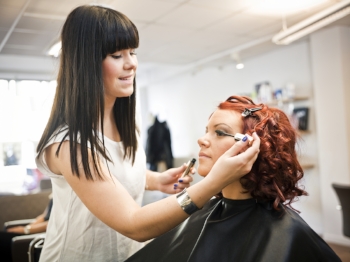I’m going to start with the passion piece of this equation. I think that we can relate a lot with this because – think about it – have you ever been to a hair show? I mean, put your hands up—yes, I’ve been to a hair show.
And we’re watching these professionals on stage and what happens? We end up buying what they’re selling, we’re signing up for their classes, we’re following them on every social media platform. We are so fired up about them. Why? What’s their secret?
I believe it’s because they’re fired up. That’s the passion. Passion is being excited about what you have to sell and what you have to offer. Excited about your services, trends…the more excited you are, the more passion you display, the more excited your clients will be. And their level of excitement will rise to meet yours. So friends, we’ve got to be passionate. You’ve got to believe in what you have to offer.
So, are you sold, really? If you’re not sold on your products or services, your clients won’t be either. You are the ones that have the power to bring passion to the chair each day. Let me say that again: You have the power to be passionate each day. It’s a choice you make, regardless of what’s happening behind the scenes. If you make this experience about them, which is the people part of sales, then you will bring the show alive and direct with the passion part of the sales. Then you will be wildly successful.
Practice makes permanent. You’re not going to become this wildly, over-the-top, passionate person overnight. You’re not going to just potentially have it already in you to put on a show and entertain the masses. But passion can come in other ways. You don’t have to just show the *crazy excitement*. You can look people in their eyes and say, “This product was a game changer.”
Here’s an example: “Donna, if I’ve heard you correctly, you are struggling with dry hair. And I get it, it’s that time of year. The winter…especially here. We are in Wisconsin. The winters are brutal. It’s dry, it’s cold, it’s awful. I mean, why do we live here? Another topic for another day."
"But, okay, so Donna, you know what? I’m going to have you leave with this conditioning mask today, and it’s going to be a game changer for you. I cannot tell you the amount of success I’ve personally had, but other clients who have said the same things, have had success with this as well. But here’s what I’m going to need you to do. I’m going to need you to commit to using this at least twice a week. Put this on twice a week. So think of a time, Donna, where you have about ten minutes to yourself. Is that in the morning? Maybe before bed? You can put this on, put on a cap, and leave it sit for ten minutes – just hang out, read a little, watch TV. Minimum of ten minutes, maximum of sixty—I mean, that’s cool too. And then you’re going to go and you’re going to rinse that out. You’re not going to wash, you’re not going to shampoo. You’re just going to rinse that out. And then here’s the next thing I need you to do Donna. I need you to blow dry your hair.”
“Why? Why not air dry? I thought that was healthier?”
“No, no, no. The technology of our blow dryers today…I mean this is not the same world we lived in when we were doing our hair back years and years ago. The blow dryers are not going to damage your hair. What will be stripping the hair though is if you let water just sit and chill. Well, we can talk about the pH scale.”
“Well, what do you mean, Kati?”
“Well think about the pH scale. Your hair, skin and nails are 4.5 to 5.5 on the pH scale. Well, where’s water? It’s at 7, it’s neutral. So even water is damaging to the hair. So we’ve got to get that water out. So, after the conditioner is rinsed, you’re going to use – I know you already have this at home – this moisturizing oil. I’m going to have you put this in, right after you get out of the shower. You towel dry, you put this oil in, and I want you to put this in. So if that makes it easier for you to do this in the morning, that’s cool, but this is going to be the game plan. And I promise you, you are going to see results.”
Now, I’m not acting or saying those recommendations to Donna in a wild, crazy, on stage way. But I’m bringing passion behind what I’m saying. Some of you who are very supportive personalities, and maybe your face turns red a little when you have to speak in front of anybody in general. And I get it; I mean I can’t relate, but I have team members who would do anything to stay behind the scenes rather than be in front of people or be onstage.
So, for you, you’re going to have to kind of go into the mindset of "I’m going on stage right now." When you go behind the chair, you’ve got to be like Beyoncé. You’ve got to cultivate that Sasha Fierce. When Beyoncé steps on stage she becomes a completely different person. When you go behind the chair, I want you to cultivate your alter ego, and bring to the table almost like you’re acting a part. I mean for real, very introverted personalities—and these are often very logical, analytical people, so you’re great at your craft—produce phenomenal results, you produce precise results for your behind the chair work, whether it be coloring or cutting.
But, you sometimes struggle to bring the creative imagination side of the brain to the table, because it’s just not naturally there. And that’s fine! I mean, there’s a place for everybody. But when you go behind the chair, my recommendation is that you pretend that you’re playing a role, this is your role in this play, you’re acting a part. And your passion doesn’t have to be unrealistic for your personality type.
So maybe your passion is compassion. I will tell you that eye contact will be the biggest key. Put your hand on their shoulder and say, “Donna, this right here is the conditioner for you. I couldn’t back a product up better that will give you the result you’re looking for today.”
And remember, practice makes permanent. Practice makes permanent. When you’re implementing new behaviors, it’s not going to become a habit overnight. You must practice positive habits each day. An Aristotle quote, one of my favorite quotes is, “We all are what we repeatedly do. Excellence then is not an act, but a habit.”
Eventually, you won’t be acting anymore. When you practice this repeatedly, it will become a habit. It will become who you are behind the chair, and you will become very successful. Your clients will be as passionate as you are. Their level of excitement will come and rise to meet yours. Passion will bring you the sales you desire.
But without the people part of this, it won’t matter how passionate you are. What do I mean? You’ve gotta love on your people. You aren’t selling products and services, you’re selling to people. We sometimes forget because we’re all saying, “Oh, here’s what this can do, and here’s what we do,” instead of saying, “Why do the people you work with care to hear about this?”
I mean, the saying is true: “People don’t care what you know until they know that you care”
So, in my opinion, for most professionals in the beauty industry, this is actually a strength of ours. Because I believe most of us got into this industry because we love people. We want to help people, we want to bring out the best in people. We want to help people look and feel good. So we’re already a step above. I mean, we’re ready to go; we love people. Sometimes we get so caught up in what we do that we forget we need to give the proper attention to the person. Especially if you get to the point where you’re double, triple booked. Then it becomes managing your schedule and time and moving people around.
But take a moment to say, “How’s your day going?” I mean, just asking people.
So how do we care for our clients so much that we can create a trusting rapport with them? Hopefully, by getting to know them. Are you genuinely engaged? Do you know how your clients like to be talked to?
There are clients—and you know what I mean, right?—they’ll come in and you’re going to be like, “Heyyy girl, have a seat. Got this new trend for you, I know you’re going to love it, it’s on point. Girl, check this out.”
And then you’re going to have other clients where you’re like, “Fabulous to see you today. Take a seat right here.”
And you sit down face to face and you lean in and say, “Tell me, how is your family doing?”
And yes, these are completely different clients. But you’ve got to understand how you talk to your different clients in different ways. Do you understand your clients’ values? Some people are going to be into different things than others. Are you remembering these things?
I mean, every salon software out there that I’m aware of, will have a little notes section that will potentially pop up for you and remind you of things. (We’ll just stick with Donna.) “Donna was on vacation last month” or “Donna is heading to Florida on vacation.” So by the time she comes in next you can be like, “Donna! How was Florida? I missed you!”
Here’s a question: What is the number one thing people want to talk about?
Themselves!
So how do you become more engaged with your clients? How do you get to know them?
You ask them questions.
And there are some personal questions, and there are questions that lead to the end result of your appointment. So, a personal question—and this is going to help you professionally so just go with me, here—a personal question you can ask your clients is, “Hey, what does your everyday life look like?”
People are going to be very excited to answer that.
And they’ll say, “Oh, I get up, I go to my workout, and I get home, eat breakfast, get the kids off to school…”
And then you can say, “Oh, let’s back up! So I’m assuming you’re going to shower after your workout; tell me, what are the top products for your shower?” Now that’s a lead-in to your professional conversation. So it’s a personal question, you’re getting to know them. And now the next time they come in, you can be like, “Hey, how are your workouts going?”
But that was also a discovery question that also led to a useful question: What’s your daily regimen with your hair?
Another leading question like that is: Do you have the time that you’d like to have every day to style your hair or apply your makeup?
“You know, I wish I had more time, but honestly I have about twenty minutes that I can allow for both.”
“I hear that, Donna. Because now that I know you only have twenty minutes to work with, I have a couple of suggestions for you.”
Another question: If you had more time, what would you like to achieve?
“Well, if I had more time, I’d love to put in those curls where it looks like waves, not like beach waves, but kind of…”
And they show you a picture and the light bulb goes off—and you’re like aha! Those are flat iron waves.
And now this is in the back of your mind: Now I’m going to show you the flat iron you need to be using, and I’m going to show you the proper product to put on your hair before you put the heat on. It’s not only going to protect your hair from the heat, it’s going to infuse protein into your hair, and it’s going to hold the curl.
Boom! Opportunity.
Another question: If you had no fear or hesitation, what would you love to try?
Now, stick with me on this. Because you don’t ask this like, “Oh, we’re going to do the whole world today, we’re going to take you from a level four to a level ten today.”
No, but it’s kind of cool to see whether this person is a risk taker, or if they’re kind of in their comfort zone. Once you know that, for future visits, you can make a note that this client, Donna, likes to push the boundaries.
That is so fun. Because you know, you can do a little change to their look—add bangs—and it changes the whole thing. You can place foils in a certain way to completely change the look of their style. You add a few highlights on top, it’s going to instantly seem like there’s more lift, more volume at the top of the crown. So that’s so cool to find out.
Then there are products and services questions, for example: What are your products not doing for you that you wish they would?
Especially maybe with new guests. They come in and you ask, “What are your products not doing for you that you wish they would?”
And they say, “Well I really like how soft my hair is, but I’m struggling with volume. I feel like my hair is lifeless.”
You look and they have blonde, Norwegian, thin hair. And you think, “Well, you probably shouldn’t be using that product…”
But you don’t say that! Instead, you say, “Oh, well I have a really awesome idea I’m going to work with you on today, and you’re going to be blown away at how much volume you can have with your hair, and not compromise the softness, the moisture, the integrity of your hair.”
Another question: On a scale from 1 to 10, how would you rate your current product over this product?
And if they say, “Well, maybe a 6…” this is your follow-up question: “What would need to happen to make it a 10?”
And she says, “Well, I love the softness, but to make it a 10 I need to have volume.”
So now you’re coming up with your game plan. You’re genuinely engaged. This is a give and take. Being great at sales, building trust so people will buy from you…it starts with the person. Getting to know them, and not just getting to know them to be their friend.
You know, when I’m hiring new stylists and I say, “Why would a client want to work with you?”
And they say, “Well I believe I can get along great with people, and I have a really great personality and I like to make people happy…”
I’m thinking in the back of my mind, “Yeah, you and every other stylist out there!”
Friends, this is why we’re going to talk about your unique selling proposition. What makes you truly unique?
Because unless you’re a complete A-hole, people are going to genuinely feel like most hair stylists are nice people. So that’s not doing it. With your client, it’s not “let’s be best friends time”. With your client, there is a way to maintain your professionalism and the fact that you are in a sales position, and still care deeply for people. Your goal is to be their professional.
And are you friendly? Do you care so much for them? Yes. But you’re their professional first.
That is if your goal is to make the earnings you’re worth. You know, I had talked before that the average stylist in America makes $30,000 a year. Across the nation, the average income for a hair professional…$30,000 a year.
Are you okay with that? I’m not! I don’t want that for the stylists that work for me. I don’t want this to be their job for a little while, that’s fun. I want hair professionals to feel that this is a long-term career, that they can retire from this career, and feel comfortable.
And so, I’m just not willing to settle for the average. And just remember, friends, the average is best of the worst or worst of the best.
I want us to be the exception.
So sales is about the people plus the passion. Here’s the sales process: People have to know you. They’ve got to know that you exist. (Oh, I’ve heard of that salon, I’ve heard of that professional.)
And then, they have to like you. We’re going to get into this a little bit further because that’s all about authenticity. Then, they’ve got to trust you. I believe trust is built when you have the opportunity to sit down and get to know them, ask questions (the right questions) and come up with solutions.
Once, they trust you, then they’ll buy from you. You know, it’s hard to say, “Oh, I’m a sales position when I’m in the service industry.”
Friends, if you don’t make sales, you don’t make money. Please, consider charging what you’re worth. You will attract the clients that believe the same things you do. Their values will match your values. There’s plenty of people to go around. This is not a world of scarcity. This is a world of abundance. There’s plenty to go around.
Don’t fear the unnecessary. Instead, focus on your potential. And remember, practice makes permanent. This won’t come overnight, but today is the day that you can implement a new mindset that will result in new behaviors, that will result in new habits. And eventually, a year from now, you will a completely different professional than you are today.
I believe you deserve it.








































